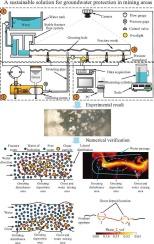Dynamic water grouting in fractured coal mass: Experimental and numerical study on granule deposition characteristics and sealing efficiency
IF 4.6
2区 工程技术
Q2 ENGINEERING, CHEMICAL
引用次数: 0
Abstract
It is challenging to control the concealability and roughness of the fracture grouting process in a water-rich environment, which makes it difficult to directly observe the grout diffusion and deposition process as well as evaluate the sealing effect. Consequently, the water-blocking mechanism remains unclear. To address this issue, this paper utilized 3D printing technology to create a transparent rough fracture model based on the random midpoint displacement method and fractal theory. Additionally, an independent water grouting test system was developed to perform dynamic water grouting tests under various working conditions. The computational fluid dynamics and two-phase flow approach (CFD-TFM) is employed for numerical simulation to ascertain the slurry diffusion patterns and deposition effects at various time intervals throughout the grouting operation. Uniaxial compression and direct shear tests were conducted to evaluate the mechanical behavior of the grout-consolidated specimens. The results indicate that the rough fracture produced by the 3D printing process exhibits effective visibility, allowing for the observable trend of grouting flow. The experimental phenomena categorize the distribution pattern of dynamic water grouting into three types: cross-section water plugging pattern, comet type, and elongated streamline type. The slurry flow trend and particle deposition effect described by the CFD-TFM method are consistent with experimental observations, and all three forms—cross-section type, comet type, and slender streamline—are evident. The concrete results indicate that the particle deposition effect follows the order: cross-section type > comet type > slender streamline. Pressure monitoring data reveal a decreasing trend from the moving water inlet to the outlet boundary. As the distance from the grouting hole increases, the drop in sensor pressure values becomes less pronounced, resulting in reduced grouting deposition. These research findings provide a theoretical basis for the design of grouting reinforcement engineering.

裂隙煤体动态水注浆:颗粒沉积特征及密封效果的实验与数值研究
在富水环境下,裂缝注浆过程的隐蔽性和粗糙度控制具有一定的挑战性,这给直接观察注浆扩散和沉积过程以及评价止水效果带来了困难。因此,阻水机制仍不清楚。针对这一问题,本文利用3D打印技术,基于随机中点位移法和分形理论,创建透明粗裂缝模型。开发了独立的水注浆试验系统,可进行各种工况下的动态水注浆试验。采用计算流体力学和两相流方法(CFD-TFM)对注浆过程中不同时间间隔的浆体扩散规律和沉降效果进行了数值模拟。通过单轴压缩试验和直剪试验对灌浆固结试件的力学性能进行了评价。结果表明,3D打印过程产生的粗裂缝具有有效的可见性,可以观察到注浆流动的趋势。实验现象将动力水灌浆的分布模式分为三种类型:断面堵水模式、彗星型和拉长流线型。CFD-TFM方法描述的浆体流动趋势和颗粒沉积效应与实验观测结果一致,截面型、彗星型和细长流线三种形式都很明显。具体结果表明:颗粒沉积效应顺序为:截面型>;彗星型>;细长流线。压力监测数据显示,从动水口向出水口边界呈下降趋势。随着距注浆孔距离的增加,传感器压力值下降幅度减小,注浆沉降量减少。研究结果为注浆加固工程的设计提供了理论依据。
本文章由计算机程序翻译,如有差异,请以英文原文为准。
求助全文
约1分钟内获得全文
求助全文
来源期刊

Powder Technology
工程技术-工程:化工
CiteScore
9.90
自引率
15.40%
发文量
1047
审稿时长
46 days
期刊介绍:
Powder Technology is an International Journal on the Science and Technology of Wet and Dry Particulate Systems. Powder Technology publishes papers on all aspects of the formation of particles and their characterisation and on the study of systems containing particulate solids. No limitation is imposed on the size of the particles, which may range from nanometre scale, as in pigments or aerosols, to that of mined or quarried materials. The following list of topics is not intended to be comprehensive, but rather to indicate typical subjects which fall within the scope of the journal's interests:
Formation and synthesis of particles by precipitation and other methods.
Modification of particles by agglomeration, coating, comminution and attrition.
Characterisation of the size, shape, surface area, pore structure and strength of particles and agglomerates (including the origins and effects of inter particle forces).
Packing, failure, flow and permeability of assemblies of particles.
Particle-particle interactions and suspension rheology.
Handling and processing operations such as slurry flow, fluidization, pneumatic conveying.
Interactions between particles and their environment, including delivery of particulate products to the body.
Applications of particle technology in production of pharmaceuticals, chemicals, foods, pigments, structural, and functional materials and in environmental and energy related matters.
For materials-oriented contributions we are looking for articles revealing the effect of particle/powder characteristics (size, morphology and composition, in that order) on material performance or functionality and, ideally, comparison to any industrial standard.
 求助内容:
求助内容: 应助结果提醒方式:
应助结果提醒方式:


